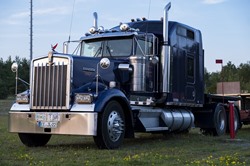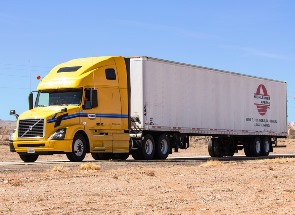How to Pick the Best Truck Driver School near Oilmont Montana
 Congrats on your decision to become a trucker and enroll in a truck driving school near Oilmont MT. Maybe it has always been your ambition to hit the open road while driving a monster tractor trailer. Or maybe you have conducted some research and have discovered that an occupation as a truck driver provides excellent pay and flexible work prospects. Regardless of what your reason is, it’s imperative to get the appropriate training by picking the right CDL school in your area. When assessing your options, there are several variables that you’ll need to examine prior to making your final selection. Location will certainly be important, especially if you have to commute from your Oilmont residence. The cost will also be of importance, but choosing a school based entirely on price is not the optimal method to ensure you’ll obtain the proper training. Don’t forget, your goal is to learn the skills and knowledge that will enable you to pass the CDL examinations and become a qualified truck driver. So keeping that target in mind, just how do you choose a truck driving school? That is what we are going to address in the rest of this article. But first, we are going to talk a little bit about which commercial driver’s license you will eventually need.
Congrats on your decision to become a trucker and enroll in a truck driving school near Oilmont MT. Maybe it has always been your ambition to hit the open road while driving a monster tractor trailer. Or maybe you have conducted some research and have discovered that an occupation as a truck driver provides excellent pay and flexible work prospects. Regardless of what your reason is, it’s imperative to get the appropriate training by picking the right CDL school in your area. When assessing your options, there are several variables that you’ll need to examine prior to making your final selection. Location will certainly be important, especially if you have to commute from your Oilmont residence. The cost will also be of importance, but choosing a school based entirely on price is not the optimal method to ensure you’ll obtain the proper training. Don’t forget, your goal is to learn the skills and knowledge that will enable you to pass the CDL examinations and become a qualified truck driver. So keeping that target in mind, just how do you choose a truck driving school? That is what we are going to address in the rest of this article. But first, we are going to talk a little bit about which commercial driver’s license you will eventually need.
Which Commercial Drivers License Will You Need?
 To operate commercial vehicles legally within the USA and Oilmont MT, an operator must get a CDL (Commercial Driver’s License). The three classes of licenses that one can qualify for are Class A, Class B and Class C. Since the subject of this article is how to pick a truck driving school, we will discuss Class A and B licenses. What distinguishes each class of CDL is the type of vehicle that the driver can operate together with the GVWR (Gross Vehicle Weight Rating) or GCWR (Gross Combination Weight Rating). Following are short explanations of the two classes.
To operate commercial vehicles legally within the USA and Oilmont MT, an operator must get a CDL (Commercial Driver’s License). The three classes of licenses that one can qualify for are Class A, Class B and Class C. Since the subject of this article is how to pick a truck driving school, we will discuss Class A and B licenses. What distinguishes each class of CDL is the type of vehicle that the driver can operate together with the GVWR (Gross Vehicle Weight Rating) or GCWR (Gross Combination Weight Rating). Following are short explanations of the two classes.
Class A CDL. A Class A Commercial Drivers License is needed to operate any vehicle that has a GCWR of more than 26,000 lbs., including a towed vehicle of greater than 10,000 lbs. A few of the vehicles that drivers may be able to operate with Class A licenses are:
- Interstate or Intrastate Tractor Trailers
- Trucks with Double or Triple Trailers
- Tanker Trucks
- Livestock Carriers
- Class B and Class C Vehicles
Class B CDL. A Class B Commercial Drivers License is required to drive single vehicles having a GVWR of greater than 26,000 lbs., or a GCWR of greater than 26,000 lbs. including a towed vehicle weighing up to 10,000 lbs. Several of the vehicles that drivers may be qualified to operate with Class B licenses are:
- Tractor Trailers
- Dump Trucks
- Cement Mixers
- Large Buses
- Class C Vehicles
Both Class A and Class B Commercial Drivers Licenses may also need endorsements to operate certain types of vehicles, for instance school or passenger buses. And a Class A licensee, with the appropriate required endorsements, can drive any vehicle that a Class B license holder is authorized to operate.
Click Here to Get Free Information on Truck Driving Schools Near You!
How to Evaluate a Truck Driver School
 Once you have determined which Commercial Drivers License you wish to obtain, you can start the undertaking of researching the Oilmont MT truck driving schools that you are looking at. As previously mentioned, cost and location will undoubtedly be your initial considerations. But it can’t be stressed enough that they must not be your only considerations. Other factors, including the experience of the instructors or the reputations of the schools are similarly or even more important. So below are a few more factors that you should research while performing your due diligence prior to enrolling in, and particularly paying for, your truck driver training.
Once you have determined which Commercial Drivers License you wish to obtain, you can start the undertaking of researching the Oilmont MT truck driving schools that you are looking at. As previously mentioned, cost and location will undoubtedly be your initial considerations. But it can’t be stressed enough that they must not be your only considerations. Other factors, including the experience of the instructors or the reputations of the schools are similarly or even more important. So below are a few more factors that you should research while performing your due diligence prior to enrolling in, and particularly paying for, your truck driver training.
Are the Schools Accredited or Certified ? Not many truck driving schools in the Oilmont MT area are accredited because of the demanding process and cost to the schools. On the other hand, certification is more typical and is provided by the Professional Truck Driver Institute (PTDI). A school is not required to become certified, but there are several advantages. Interested students recognize that the training will be of the highest quality, and that they will receive plenty of driving time. For example, PTDI mandates 44 hours of real driving time, not simulations or ride-alongs. So if a school’s program is certified (the program, not the school is certified), students know that the training and curriculum will measure up to the very high benchmarks set by PTDI.
How Long in Business? One indicator to help assess the quality of a truck driver school is how long it has been in operation. A negatively reviewed or a fly by night school normally will not be in business very long, so longevity is a plus. On the other hand, even the top Oilmont MT schools had to begin from their first day of training, so use it as one of several qualifications. You can also ask what the school’s track record is relating to successful licensing and employment of its graduates. If a school won’t provide those numbers, look elsewhere. The schools should additionally maintain associations with local and national trucking firms. Having a large number of contacts not only affirms a superior reputation within the profession, but also bolsters their job placement program for graduates. It also wouldn’t hurt to contact the Montana licensing authority to verify that the CDL trucking schools you are considering are in good standing.
How Effective is the Training? As a minimum requirement, the schools must be licensed in Montana and employ teachers that are trained and experienced. We will cover more about the instructors in the next section. Also, the student to instructor proportion should be no greater than 4 to 1. If it’s any higher, then students will not be receiving the individual attention they will need. This is particularly true concerning the one-on-one instruction for behind the wheel training. And watch out for any school that professes it can teach you to drive trucks in a relatively short time frame. Training to be an operator and to drive a tractor trailer professionally requires time. Most Oilmont MT schools provide training programs that range from 3 weeks to as long as 2 months, depending on the license class or type of vehicle.
How Good are the Teachers? As previously stated, it’s imperative that the teachers are trained to teach driving techniques and experienced as both drivers and instructors. Even though several states have minimum driving time criteria to qualify as an instructor, the more successful driving experience a teacher has the better. It’s also important that the instructors stay current with industry developments or any new regulations or changes in existing laws. Evaluating teachers may be a little more intuitive than other criteria, and possibly the best method is to pay a visit to the school and speak with the teachers in person. You can also speak with some of the students going through the training and ask if they are satisfied with the quality of instruction and the teacher’s ability to train them.
Sufficient Driving Time? Most importantly, a great truck driving school will furnish plenty of driving time to its students. After all, isn’t that what it’s all about? Driving time is the actual time spent behind the wheel driving a truck. Although the use of simulators and ride-a-longs with other students are necessary training methods, they are no replacement for actual driving. The more instruction that a student gets behind the wheel, the better driver she or he will be. Although driving time fluctuates among schools, a reasonable standard is 32 hours at a minimum. If the school is PTDI certified, it will furnish at least 44 hours of driving time. Check with the Oilmont MT schools you are considering and ask how much driving time they provide.
Are they Captive or Independent ? You can receive free or discounted training from certain truck driving schools if you enter into an agreement to drive for a specific carrier for a defined amount of time. This is referred to as contract training, and the schools that offer it are called captives. So instead of maintaining affiliations with a wide range of trucking lines that they can refer their students to, captives only refer to one company. The tradeoff is receiving less expensive or even free training by giving up the freedom to initially work wherever you have an opportunity. Obviously contract training has the potential to limit your income prospects when beginning your new career. But for some it may be the ideal way to get affordable training. Just remember to inquire if the Oilmont MT schools you are contemplating are captive or independent so that you can make an informed decision.
Provide CDL Testing Onsite? There are a number of states that will allow third party CDL testing onsite of truck driver schools for its graduates. If onsite testing is available in Montana, find out if the schools you are reviewing are DMV certified to offer it. One benefit is that it is more accommodating than competing with graduates of competing schools for test times at Montana testing facilities. It is moreover an indicator that the DMV deems the approved schools to be of a superior quality.
Are the Class Times Convenient? As earlier mentioned, truck driving training is only about 1 to 2 months long. With such a short duration, it’s important that the Oilmont MT school you enroll in provides flexibility for both the scheduling of classes and the curriculum. For example, if you’re having a hard time learning a certain driving maneuver, then the teacher should be prepared to spend more time with you until you are proficient. And if you’re still employed while going to training, then the class scheduling must be flexible enough to accommodate working hours or other responsibilities.
Is Job Placement Offered? The moment you have received your CDL license after graduating from trucking school, you will be eager to begin your new profession. Verify that the schools you are looking at have job assistance programs. Find out what their job placement ratio is and what average salary their grads start at. Also, find out which national and local trucking firms their graduates are placed with for employment. If a school has a poor job placement rate or few Oilmont MT employers hiring their graduates, it might be a sign to search elsewhere.
Is Financial Assistance Given? Truck driver schools are much like colleges and other Oilmont MT area technical or vocational schools when it comes to loans and other forms of financial assistance being offered. Find out if the schools you are assessing have a financial assistance department, or at least someone who can help you get through the options and forms that must be submitted.
Truck Driving Classes Oilmont Montana
 Choosing the right truck driving school is an important first step to starting your new vocation as a long distance or local truck driver. The skills taught at school will be those that mold a new career behind the wheel. There are several options available and understanding them is critical if you are going to succeed as an operator. You originally came to our website because of your interest in Truck Driving Classes and wanting information on the topic How To Get A Truck Driving License. However, you must get the proper training in order to operate a large commercial vehicle in a professional and safe manner. If you are short on money or financing, you might want to look into a captive school. You will pay a reduced or even no tuition in exchange for driving for their contracted carrier. Or you can enroll in an independent truck driving school and have the option of driving for the trucking firm of your choosing, or one of several associated with the school. It’s your choice. But regardless of how you get your training, you will soon be joining a profession that helps our country move as a professional trucker in Oilmont MT.
Choosing the right truck driving school is an important first step to starting your new vocation as a long distance or local truck driver. The skills taught at school will be those that mold a new career behind the wheel. There are several options available and understanding them is critical if you are going to succeed as an operator. You originally came to our website because of your interest in Truck Driving Classes and wanting information on the topic How To Get A Truck Driving License. However, you must get the proper training in order to operate a large commercial vehicle in a professional and safe manner. If you are short on money or financing, you might want to look into a captive school. You will pay a reduced or even no tuition in exchange for driving for their contracted carrier. Or you can enroll in an independent truck driving school and have the option of driving for the trucking firm of your choosing, or one of several associated with the school. It’s your choice. But regardless of how you get your training, you will soon be joining a profession that helps our country move as a professional trucker in Oilmont MT.
Truck On in These Other Montana Locations
Toole County, Montana
Toole County is a county in the northern portion of the U.S. state of Montana. As of the 2010 United States Census, the population was 5,324.[1] Its county seat is Shelby.[2] The county was established in 1914 from parts of Hill County and Teton County and was named after Joseph Toole, the first and fourth governor of Montana. Its northern boundary is the Canada–United States border south of Alberta.
Its northern boundary is the Canada–United States border. A part of its southern boundary by the SW county corner is formed by Marias River, which flows eastward through the southern part of the county. In the eastern part are several creeks, the largest of which is Willow, which rises in the Sweet Grass hills and follows a southerly course through the county. In the Sweet Grass hills and elsewhere indications of oil and gas have been found.
As of the 2000 United States Census,[9] there were 5,267 people, 1,962 households, and 1,308 families in the county. The population density was 3 people per square mile (1/km²). There were 2,300 housing units at an average density of 1 per square mile (0.5/km²). The racial makeup of the county was 93.89% White, 0.15% Black or African American, 3.19% Native American, 0.30% Asian, 0.02% Pacific Islander, 0.32% from other races, and 2.13% from two or more races. 1.16% of the population were Hispanic or Latino of any race. 23.0% were of German, 19.4% Norwegian, 10.2% Irish, 8.3% American and 8.3% English ancestry. 93.7% spoke English, 4.2% German and 1.3% Spanish as their first language.
